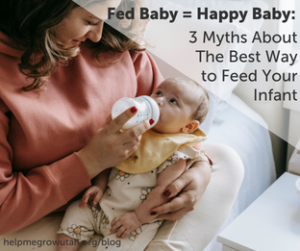 Becoming a parent is a life-changing, thrilling and remarkable experience! However, there is a common tendency for mothers to feel guilty about anything that happens to their baby, whether it be inside or outside their control. We live in a world where onlookers are quick to point fingers and shame mothers for ANYTHING that they do. Work a part-time job while you have kids at home and you get labeled as a negligent caretaker. Become a stay-at-home mom full-time and you are shamed for giving in to traditional and ‘outdated’ gender roles. The absolute worst of these disagreements and shameful conversations surrounds breastfeeding vs bottle feeding. There are tons of misconceptions and judgments made about this topic, so today we will BUST 3 common myths about breastfeeding!
Becoming a parent is a life-changing, thrilling and remarkable experience! However, there is a common tendency for mothers to feel guilty about anything that happens to their baby, whether it be inside or outside their control. We live in a world where onlookers are quick to point fingers and shame mothers for ANYTHING that they do. Work a part-time job while you have kids at home and you get labeled as a negligent caretaker. Become a stay-at-home mom full-time and you are shamed for giving in to traditional and ‘outdated’ gender roles. The absolute worst of these disagreements and shameful conversations surrounds breastfeeding vs bottle feeding. There are tons of misconceptions and judgments made about this topic, so today we will BUST 3 common myths about breastfeeding!
Bottle Feeding is Bad
Breastfeeding has an extensive list of positive health impacts, such as protection against some short- and long-term illnesses, an increase of antibodies in the baby from the mother, and a reduced risk of ovarian and breast cancer in the mother. That being said, bottle feeding is totally a healthy and safe alternative for any mother who is not able, or chooses not to breastfeed! Since the late 1800’s formula companies have worked to make nutrient-dense baby formula, enhanced and fortified with all the necessary minerals and vitamins to help your baby grow!
Everyone Breastfeeds
Many mothers are physically unable to breastfeed. Nipple pain and fissures are common, and if these symptoms are not treated, they can develop into mastitis, a painful infection that stops you from breastfeeding. In the United States, about 80% of babies are exclusively breastfed right after birth, but that number drops to about 20% after 6 months. Sometimes, the choice to breastfeed is financial. If you are a working mother, the logistics of somehow breastfeeding your baby for up to 2 hours, 4-5 times a day is impossible! While some companies have breastfeeding policies in place, many women have to choose between a hungry baby or taking frequent unpaid breaks for feedings. You are not alone whether you choose to breast or bottle feed!
Everyone Already Knows How to Breastfeed
Despite the assumption that breastfeeding is a natural human instinct, a lot of education is required to make breastfeeding run smoothly. Breastfeeding education includes any breastfeeding material taught by someone with expertise or training in lactation. This could include pre-natal classes attended by pregnant mothers either in a clinical setting like a doctor’s office or health clinic, or at locations such as libraries, community centers, churches, work sites, and schools. Breastfeeding education can also include postpartum training after birth. The goal of these classes is to help all mothers feel comfortable and capable of breastfeeding. They may educate the mother on how to know when the baby is full or what position is best to sit in while the baby eats. Hands-on breastfeeding education allows the mother to learn proper form which helps the baby to get the most bang for their buck out of breastfeeding.
If you are expecting or plan to become pregnant in the next year, find the nearest breastfeeding course, online or locally. Learn about how your work schedule would complement or conflict with a breastfeeding schedule. Search for ways to get discounted formulas through government grants or organizations that donate these supplies. Find out which method would work best for you, and don’t be afraid to do so through trial and error!
In reality, knowledge is power. Having more resources available that teach mothers about breastfeeding can encourage healthier weight in babies, and keep them full and happy. Teaching about breastfeeding allows each mother to make an informed decision, and increases the number of healthy and fed babies worldwide. In the end, the best baby is a well-fed baby.





